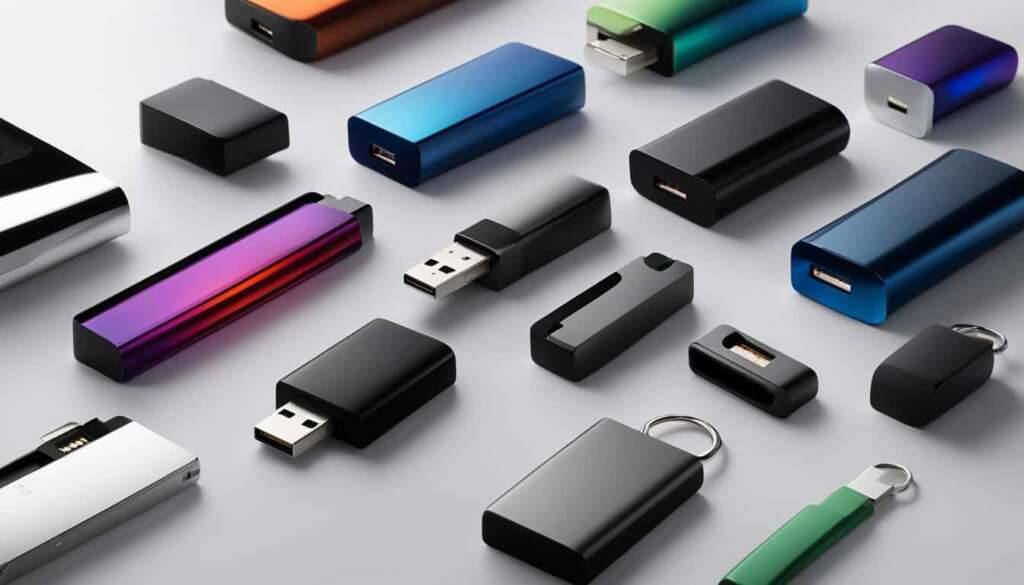Table of Contents
USB storage devices have become an essential part of digital life, enabling users to store and transfer data conveniently and securely. These devices are small and portable, making them ideal for professionals, students, and individuals who need to transfer files quickly. This section will dive into the concept of USB storage devices, discussing their functions and practical applications.
Key Takeaways
- USB storage devices provide a portable and convenient method for backing up important files and data.
- They are commonly used for file transfer between different devices, such as from a computer to a printer or smart TV.
- USB drives can also serve as a means of carrying important files on the go, making them a handy tool for professionals.
- Practical uses of USB storage devices include educational settings, businesses, and media professionals.
- USB storage devices provide convenience and flexibility in managing and sharing digital files.
What is a USB Storage Device?
A USB storage device, also known as a USB drive or flash drive, is a portable electronic device used for storing and transferring digital data. It features a USB (Universal Serial Bus) interface, enabling it to connect to computers and laptops, among other compatible devices, for easy data transfer. The storage capacity of USB drives typically ranges from a few gigabytes to several terabytes, making them a versatile solution for those in need of extra storage space.
USB Storage Device Types
There are several types of USB storage devices, including:
| Type | Description |
|---|---|
| Standard USB Drives | The most common type of USB storage device, available in various storage capacities and designs. |
| Micro USB Drives | Smaller than standard USB drives and often used in smaller devices like smartphones and tablets. |
| SSD USB Drives | Feature solid-state drive (SSD) technology, providing faster read and write speeds than standard USB drives. |
Fun Fact: The first USB drive was introduced in 2000 by IBM and had a storage capacity of 8 MB.
USB storage devices are widely used due to their portable and versatile nature. They are ideal for backing up important files and data, transferring files between different devices, and carrying important files on the go. Additionally, they have practical applications in various industries, such as education, businesses, and photography.
Functions of USB Storage Devices
USB storage devices are multi-functional tools that offer a range of practical uses. Firstly, they provide a portable and convenient method for backing up important files and data. By simply plugging the USB drive into a computer, users can quickly transfer files for safekeeping or create duplicates as a precautionary measure. This assures users that their data is not lost or damaged in case of computer failure or other malfunctions.
Moreover, USB storage devices are commonly used to transfer files between different devices, such as from a computer to a printer or from a laptop to a smart TV. This makes them ideal for sharing documents, photos, music, and videos with ease. Users can easily move their files from one device to another without the need for a network connection.
Furthermore, USB drives can also serve as a means of carrying important files on the go, especially for professionals who need to access their work outside of their primary computing device. They can store business presentations, proposals, and other types of work-related data in a convenient and compact device. This enables professionals to take their data with them wherever they go, ensuring they have access to their work at any time.
In summary, USB storage devices are versatile tools that serve multiple functions, including data backup, file transfer, and carrying important files on the go. They are practical solutions for various uses from personal to professional settings.
Practical Uses of USB Storage Devices
USB storage devices have become essential tools in today’s technological landscape, providing convenient data storage and transfer solutions. Here are a few practical applications that highlight the versatility of USB storage devices:
Education
USB storage devices are widely used in academic settings, particularly for students who need to store and transport large files, such as presentations, project reports, and research papers. With USB drives, learners can easily carry their digital resources to classes, study sessions, or computer labs without the need for an internet connection. Moreover, using USB storage devices helps students maintain a backup of their files, which can be critical in case of system crashes or data loss.
Business
Businesses rely on USB storage devices to store and transfer data quickly and efficiently. These devices are particularly handy for employees working on multiple computers and need to access files from different locations. USB drives allow for seamless data transfer between devices, enabling a streamlined workflow and project management. Additionally, USB storage devices can help maintain a backup of the essential data in case of a technical failure or system crash.
Photography and Videography
Photographers and videographers require large storage options to store their media files. USB storage devices provide lightning-fast transfer speeds, making them an ideal tool for transferring images and videos from cameras to workstations. Creating backups of media files with USB storage devices ensures that photographers and videographers can keep their data safe, preventing loss and critical downtime.
Troubleshooting and System Maintenance
Lastly, USB storage devices can serve as tools for troubleshooting and system maintenance. They can be used to boot operating systems, run portable applications, and carry diagnostic tools, making them versatile tools for computer professionals and advanced users. With a USB storage device, users can easily perform system maintenance, repair failures, and protect against system vulnerabilities.
| Application/Feature | Advantages | Disadvantages |
|---|---|---|
| Education | Easy to transport, backup files, no internet required | Storage limit, prone to loss/damage |
| Business | Fast data transfer, mobile storage, can maintain backups | Data security risks, loss/damage, limited storage |
| Photography and Videography | Fast transfer speeds, large capacity | Prone to damage/loss, limited storage |
| Troubleshooting and System Maintenance | Portable, can run operating systems and diagnostic tools | Can carry viruses/malware, limited storage |
Overall, USB storage devices offer a range of practical uses in different settings. They provide convenient storage and transfer solutions, enabling individuals and businesses to remain productive and efficient in today’s digital age.
Conclusion
USB storage devices have become indispensable tools in today’s digital age. They offer a portable and reliable way to store, transfer, and access data. Whether for personal, educational, or professional use, USB storage devices provide convenience and flexibility in managing and sharing digital files.
With their various functions and practical uses, USB drives have become an essential component of modern computing. The ability to transfer files between devices, store backup copies of important data, and carry files on the go makes them a valuable tool for individuals and businesses alike.
As technology continues to advance, USB storage devices are likely to evolve and become even more versatile and convenient. However, their core function of providing a portable and efficient way to store, transfer, and access digital data will always remain a key feature.
Therefore, it is essential to understand the benefits of USB storage devices and how they can be utilized in various settings. Stay organized and keep your important data close at hand with these compact and powerful devices.
FAQ
What is a USB storage device?
A USB storage device, also known as a USB drive or flash drive, is a portable electronic device used for storing and transferring digital data. It connects to computers and other compatible devices through a USB interface, allowing for easy data transfer.
What are the functions of USB storage devices?
USB storage devices serve multiple functions. They provide a portable and convenient method for backing up important files, transferring files between devices, and carrying important data on the go. They are also utilized for sharing documents, photos, music, and videos with ease.
What are the practical uses of USB storage devices?
USB storage devices have practical applications in various settings. They are commonly used in educational environments for storing and transporting learning materials. They are also relied upon by businesses for data storage and transfer, enabling seamless collaboration. Additionally, they are useful tools for photographers, videographers, and professionals who need to quickly transfer large media files and access their work outside of their primary computing device.
Are USB storage devices versatile?
Yes, USB storage devices are highly versatile. They can be used for booting operating systems or running portable applications, making them valuable tools for troubleshooting and system maintenance.
Why are USB storage devices essential in today’s digital age?
USB storage devices have become indispensable in managing and sharing digital files. They offer a portable and reliable solution for storing, transferring, and accessing data, providing convenience and flexibility for personal, educational, and professional use.












